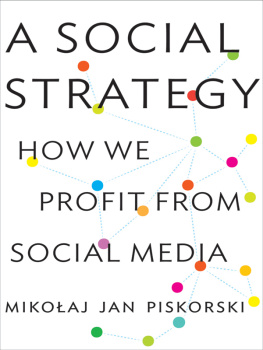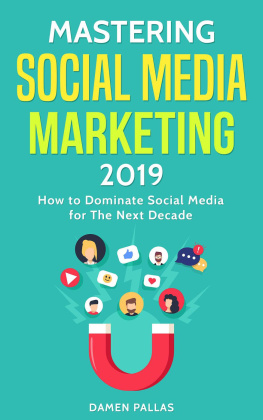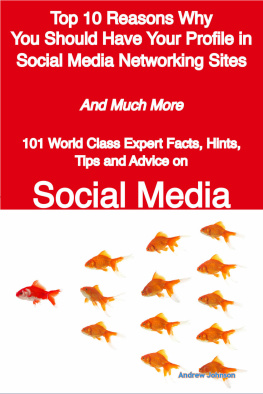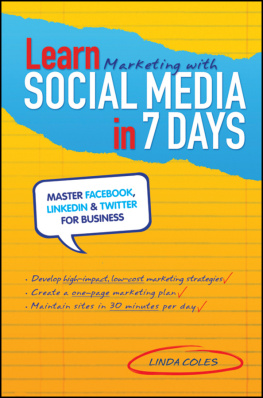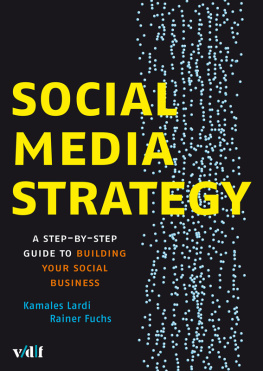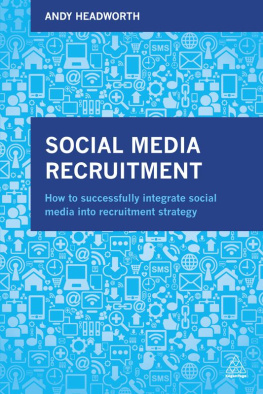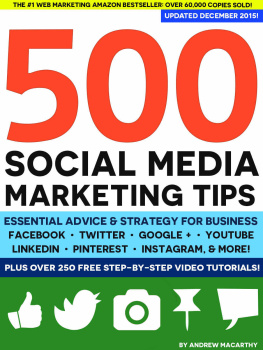A SOCIAL STRATEGY
A SOCIAL
STRATEGY
HOW WE
PROFIT FROM
SOCIAL MEDIA
MIKOAJ JAN PISKORSKI
PRINCETON UNIVERSITY PRESS
Princeton & Oxford
Copyright 2014 by Mikoaj Jan Piskorski
Requests for permission to reproduce material from this work
should be sent to Permissions, Princeton University Press
Published by Princeton University Press, 41 William Street,
Princeton, New Jersey 08540
In the United Kingdom: Princeton University Press, 6 Oxford Street,
Woodstock, Oxfordshire OX20 1TW
press.princeton.edu
All Rights Reserved
L IBRARY OF C ONGRESS C ATALOGING-IN -P UBLICATION D ATA
Piskorski, Mikoaj Jan.
A social strategy : how we profit from social media / Mikoaj Jan Piskorski.
pages cm
Includes bibliographical references and index.
ISBN 978-0-691-15339-1 (alk. paper)
1. Internet marketing. 2. Social mediaEconomic aspects. 3. Online social networksEconomic aspects. I. Title.
HF5415.1265.P57 2014
658.872dc23 2013035547
British Library Cataloging-in-Publication Data is available
This book has been composed in Sabon Next LT Pro and Ideal Sans
Printed on acid-free paper 
Printed in the United States of America
10 9 8 7 6 5 4 3 2 1
CONTENTS
PREFACE
I vividly remember sitting in my office at the Stanford Graduate School of Business in April 2003 when two men knocked on my door asking if they could have a word. By then I had done a fair amount of research on offline social networks and had written a paper on how social networks can help venture capitalists gain recognition. As a result, many newly minted (and always impeccably dressed) venture capitalists dropped in on me, looking for additional insights. I figured these two fell in the same categoryexcept they werent dressed as sharply.
It turned out, though, that they werent venture capitalists at all; they wanted to talk to me about a company they were about to launch, one that involved online networking. A number of similar companies had sprung up in the area, and their founders had all secured Stanford professors who studied social networks as their advisors. As the most junior professor on campus who studied social networks, I was the only one unspoken for, and so these two gentlemen sought me out to be their sounding board.
Their site, soon to be released to the public, would let people create professional profiles to display their educational and work achievements and publicly indicate their business relationships. People could then use the online network to offer or seek consulting engagements, expertise, or financing.
The idea sounded interesting to me, but I did not believe it was going to succeed. Why reinvent the wheel? I thought. We already know that networks work very well, and people already get jobs through networks. In fact, a classic sociological work by Mark Granovetter (1974) had long ago demonstrated that a significant percentage of jobs are obtained through personal networks. Clearly, offline networks do what they are supposed to do, and have done so for centuries, so why would we need to network online? I was polite with my comments, but I was politely negative and we parted ways.
Later that day, as I was driving back home to San Francisco on Interstate 280, I continued to think about just how much I did not like the online networking idea. Then, as I was approaching the intersection with Route 92 that takes you to Half Moon Bay, and admiring the fog rolling over the Santa Cruz Mountains, it dawned on me that I was wrong. I remember thinking: We have all of these theories in sociologyabout how networks work, how they help us, and how they are better than markets. But what if these networks do not perform as the theory says? What if there are many social interactions that would make people happier, but these interactions simply do not happen? We have no theory that tells us when social relationships might not work. And if there are many missing social interactions, then there is a huge opportunity for new ventures to help people interact with one another! My visitors were right and they were onto something really big!
By the time I got to San Francisco, I was completely convinced that I needed to contact the two men, retract most of what I had said, and ask them to meet with me again. I emailed them as soon as I got home, and the two gentlemen, Reid Hoffman and Konstantin Guericke, agreed to meet again. Just a few years later, their company, LinkedIn, had prevailed over its erstwhile competitors. Within eight years, LinkedIn reported $65 million profit on $500 million revenue and debuted on the New York Stock Exchange with one hundred million users and a $10 billion valuation. When this book was going into print, the company was valued at $25 billion. Sadly, I had nothing to do with the companys success. (In fact, I have no formal paid relationships with any of the companies discussed in this book.) But the interaction with Hoffman and Guericke changed my research trajectory for the next ten years. I document this research in this book.
LinkedIns Critical Choice
LinkedIns road to success was not straightforward. Indeed, in the summer of 2005, Reid Hoffman found himself facing a critical decision regarding the companys future. By then, the company had amassed five million users, but it had very little revenue to show to investors. Furthermore, it had only five million dollars in cash reserves, which would allow it to survive for just another nine months without an infusion of cash from venture capitalists. Given about a six-month lead required to obtain financing, LinkedIn had to start generating revenue quickly, or the terms of financing would be very unfavorable.
In deciding how to generate revenue, Hoffman had to make sure that he did not undermine the basic principles that had allowed the company to attract users. For example, LinkedIn had always encouraged users to form online connections only with people they actually knew offline. It also allowed members to contact only those members who were no more than four degrees of separation, and every time someone wanted to contact someone else on the platform, the chain of friends connecting the sender and the receiver had to approve the communication. This fostered a trustworthy online environment and reduced the incidence of spam, which helped LinkedIn prevail over competitors.
The company also had to be mindful about its superusersindividuals who were so committed to the site that they used a separate computer dedicated only to their LinkedIn activities. Often referred to as networkers, these users had established many online relationships on LinkedIn and played critical roles in connecting other users by forwarding their requests.
Hoffman and his team entertained two options. The first entailed keeping the existing free service intact, but offering a fifteen-dollar subscription for a bundle of eight new services that would help LinkedIn members search the site and manage interactions more effectively. This option garnered significant support because it helped the sites most active users, the networkers. It also offered the promise of steady cash-flow streams associated with monthly subscriptions.
The second option called for allowing members to contact each other directly, regardless of whether they were connected to each other through intermediaries. LinkedIn would charge a fee for such communicationroughly equivalent to ten dollars per message. The company had received some requests for this functionality and estimated it to be a profitable option. Many people worried, however, that pursuing this option could lead to the platforms demise. First, if anyone could contact anyone, then there would be much less need for the networkersthe most active site memberswho would probably abandon the site. Second, allowing users to contact anyone on the network would violate LinkedIns basic premiseits commitment to privacypotentially leading to massive user defection.

